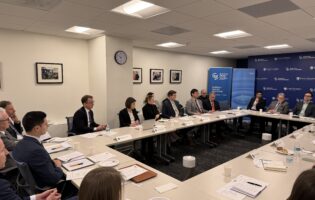Immigrants in Foreign Policy Making in Germany and the U.S.: Two Very Different Struggles to Embrace Diversity
On October 25, 2011, the American Institute for Contemporary Studies (AGI) hosted a discussion on “Immigrants in Foreign Policy Making in Germany and the U.S.: Two Very Different Struggles to Embrace Diversity.” During her talk, Ms. Henriette Rytz, DAAD/AGI Fellow, analyzed how and why immigrant engagement in foreign policy making differs in Germany and the United States. She explained the differences by drawing upon four different factors, namely the political systems, national self-conceptions, societal attitudes towards immigration, and participation resources.
In the beginning of her presentation, Ms. Rytz pointed out that participation by immigrants in foreign policy making in the U.S. has become a regular element of domestic politics. Americans with a hyphenated identity confidently voice their interests with regard to their countries of origin. In contrast, immigrants in Germany are far less prominent in the foreign policy process. This can be seen in current media representation, in which foreign policy actors who emphasize their migrant background are hardly present. Moreover, an active debate about merits and legitimacy of ethnic interest groups takes place in the U.S., whereas in Germany such a debate is mostly absent.
Ms. Rytz argued that by recognizing the various shades of immigrant participation, it becomes easier to compare the situation in the U.S. and Germany. Immigrants in Germany do organize and voice foreign policy interests. However, the labels and channels differ from the ones in the U.S. The differences in the forms of immigrant participation become visible in the terminology. For instance, German ethnic interest groups are usually referred to as Migrantenselbstorganisationen (immigrant self organizations), which shows that such an independent thrust is not to be taken for granted.
The differences in political channels, labels, and levels of immigrant participation in foreign-policy making, Ms. Rytz argued, can be explained by four different factors.
- The political system: The manner in which immigrants engage in politics is determined to a large degree by the political system in which they act. While the German system centers on political parties, the U.S. system centers on individual political entrepreneurs. The American system is hence much more permeable to interest groups. The German focus on political parties, in contrast, results in a more static system with lower turnover and less permeability to interest groups.
- National self-conceptions: The different approaches toward citizenship reflect different national self-conceptions. While the U.S. calls itself a country of immigration, Germany has only recently started accepting this label. As a result, hyphenated identities and ethnic political activism are less conceivable to the German than the American public. The differences in national self-conceptions are reflected by citizenship legislation. Germany’s bureaucratic approach to citizenship imposes high hurdles for naturalization, which may also be revoked. The American idealistic approach, in contrast, embraces hyphenated identities and grants citizenship for good. The differences in national self-conceptions can also be linked to a different awareness of international developments. The self-definition of a society thus impacts the political space for immigrants.
- Societal attitudes toward immigration: Germany’s long resistance to define itself as a country of immigration was grounded in the belief that the guest workers would eventually return to their countries of origin. In the U.S., however, due to the notion of being a country of immigration, immigrants are generally expected to stay. The very concept of hyphenated identities makes room for a broader acceptance of foreign policy activism of immigrants. Attitudes toward immigration thus impact the integration of immigrants into politics, in particular into foreign-policy making.
- Participation resources: The three aforementioned conditions influence the participation resources, such as time and education, which immigrants need to engage in politics. With social mobility being more difficult to achieve in Germany, it also becomes more difficult to gain the necessary participation resources.
Ms. Rytz concluded that political participation of immigrants is a powerful instrument for, as well as an outcome of, integration. By making use of the political instruments offered by the country of settlement, immigrants demonstrate their integration on the political level. If political channels were more open to immigrants in Germany, maybe “self-organization” would become less attractive. At the same time, societal integration would also make it more attractive to immigrants to join German associations rather than found their own. However, although the United States is much more open to the participation of immigrants in foreign-policy making than Germany, it is also struggling to embrace diversity. The highly emotional debate over whether the pursuit of ethnic interests distorts the national interest is a case in point. In the long run, the integration of newcomers through social mobility could be challenged if the current job crisis persists and if anti-immigrant legislation further spreads on the state level.







